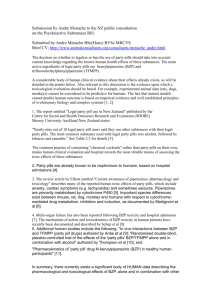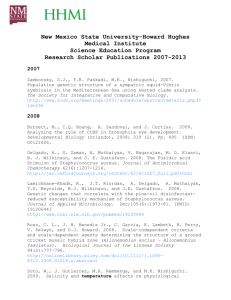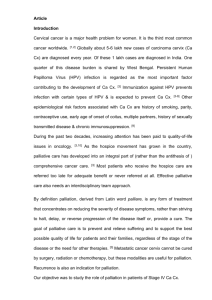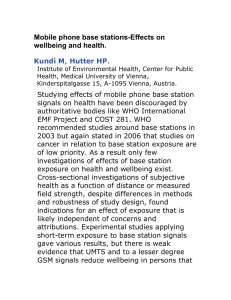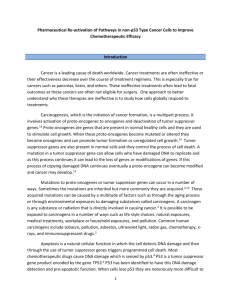School Address - Families Online
advertisement
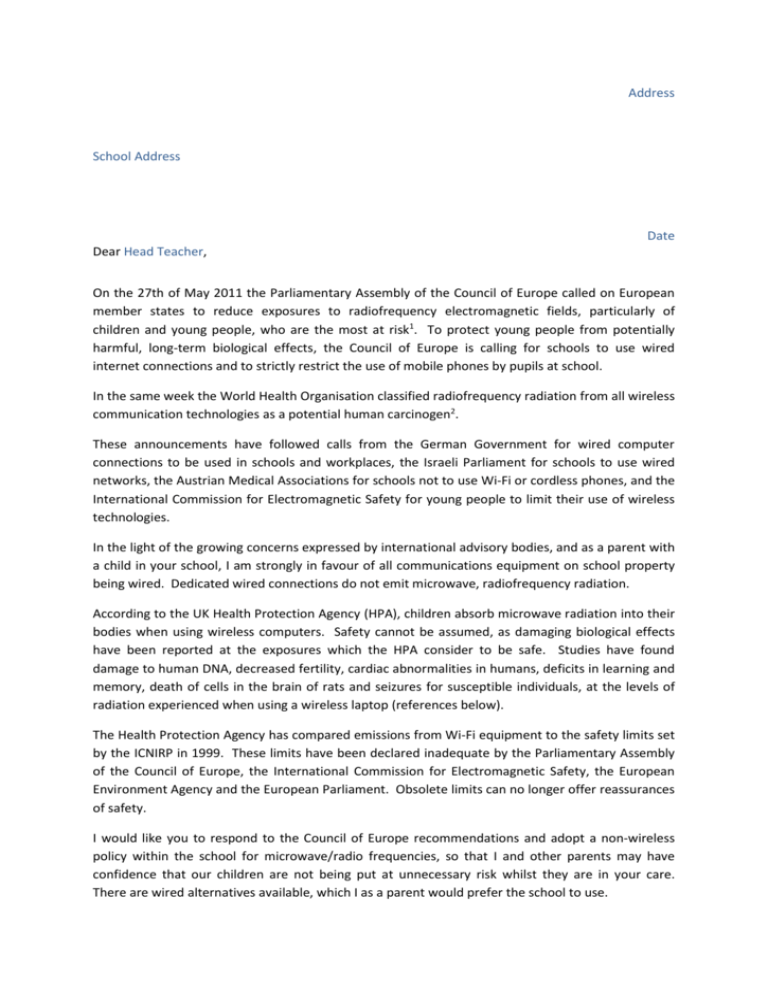
Address School Address Date Dear Head Teacher, On the 27th of May 2011 the Parliamentary Assembly of the Council of Europe called on European member states to reduce exposures to radiofrequency electromagnetic fields, particularly of children and young people, who are the most at risk1. To protect young people from potentially harmful, long-term biological effects, the Council of Europe is calling for schools to use wired internet connections and to strictly restrict the use of mobile phones by pupils at school. In the same week the World Health Organisation classified radiofrequency radiation from all wireless communication technologies as a potential human carcinogen2. These announcements have followed calls from the German Government for wired computer connections to be used in schools and workplaces, the Israeli Parliament for schools to use wired networks, the Austrian Medical Associations for schools not to use Wi-Fi or cordless phones, and the International Commission for Electromagnetic Safety for young people to limit their use of wireless technologies. In the light of the growing concerns expressed by international advisory bodies, and as a parent with a child in your school, I am strongly in favour of all communications equipment on school property being wired. Dedicated wired connections do not emit microwave, radiofrequency radiation. According to the UK Health Protection Agency (HPA), children absorb microwave radiation into their bodies when using wireless computers. Safety cannot be assumed, as damaging biological effects have been reported at the exposures which the HPA consider to be safe. Studies have found damage to human DNA, decreased fertility, cardiac abnormalities in humans, deficits in learning and memory, death of cells in the brain of rats and seizures for susceptible individuals, at the levels of radiation experienced when using a wireless laptop (references below). The Health Protection Agency has compared emissions from Wi-Fi equipment to the safety limits set by the ICNIRP in 1999. These limits have been declared inadequate by the Parliamentary Assembly of the Council of Europe, the International Commission for Electromagnetic Safety, the European Environment Agency and the European Parliament. Obsolete limits can no longer offer reassurances of safety. I would like you to respond to the Council of Europe recommendations and adopt a non-wireless policy within the school for microwave/radio frequencies, so that I and other parents may have confidence that our children are not being put at unnecessary risk whilst they are in your care. There are wired alternatives available, which I as a parent would prefer the school to use. The document ‘Wireless technologies and young people’, listed below, may be useful when considering health, safety and ICT policies3. Thank you for your help with this important issue. Sincerely, Links 1. Council of Europe http://assembly.coe.int/ASP/NewsManager/EMB_NewsManagerView.asp?ID=6685&L=2 2. W.H.O. http://www.iarc.fr/en/media-centre/pr/2011/pdfs/pr208_E.pdf 3. ‘Wireless technologies and young people’ http://wifiinschools.org.uk/resources/wireless+technologies+and+young+people+Jan2011.pdf Some references for biological effects at Wi-Fi exposures: Avendaño C. et al., 2010. Laptop expositions affect motility and induce DNA fragmentation in human spermatozoa in vitro by a non-thermal effect: a preliminary report. American Society for Reproductive Medicine 66th Annual Meeting: O-249 http://wifiinschools.org.uk/resources/laptops+and+sperm.pdf Panagopoulos D. J. et al., 2010. Bioeffects of mobile telephony radiation in relation to its intensity or distance from the antenna. Int. J. Radiat. Biol. Vol 86(5):345-357. http://www.ncbi.nlm.nih.gov/pubmed/20397839 Pyrpasopoulou A. et al., 2004. Bone morphogenic protein expression in newborn kidneys after prenatal exposure to radiofrequency radiation. Bioelectromagnetics 25:216-27. http://www.ncbi.nlm.nih.gov/pubmed/15042631 Kesari K. K. and Behari J., 2009. Microwave exposure affecting reproductive system in male rats. Appl. Biochem. Biotechnol. 162(2):416-428. http://www.ncbi.nlm.nih.gov/pubmed/19768389 Otitoloju A. A. et al., 2010. Preliminary study on the induction of sperm head abnormalities in mice, Mus musculus, exposed to radiofrequency radiations from Global System for Mobile Communication Base Stations. Bull. Environ. Contam. Toxicol. 84(1):51-4. http://www.ncbi.nlm.nih.gov/pubmed/19816647 Salama N. et al., 2010. Effects of exposure to a mobile phone on testicular function and structure in adult rabbit, International Journal of Andrology 33(1):88-94. http://www.ncbi.nlm.nih.gov/pubmed/19076254 Havas M. et al., 2010. Provocation study using heart rate variability shows microwave radiation from 2.4GHz cordless phone affects autonomic nervous system. European Journal of Oncology Library Vol. 5: 273-300. http://www.icems.eu/papers.htm?f=/c/a/2009/12/15/MNHJ1B49KH.DTL part 2. Kesari K. K. and Behari J., 2009. Fifty-gigahertz microwave exposure effect of radiations on rat brain. Appl. Biochem. Biotechnol. 158:126-139. http://www.ncbi.nlm.nih.gov/pubmed/19089649 Salford L. G. et al., 2010. Effects of microwave radiation upon the mammalian blood-brain barrier. European Journal of Oncology Library Vol. 5:333-355. http://www.icems.eu/papers.htm?f=/c/a/2009/12/15/MNHJ1B49KH.DTL part 2. Salford L. G., et al., 2003. Nerve cell damage in mammalian brain after exposure to microwaves from GSM mobile phones. Environ. Health Perspect. 111:881-883. http://www.ncbi.nlm.nih.gov/pubmed/12782486 Persson B. R. R. et al., 1997. Blood-brain barrier permeability in rats exposed to electromagnetic fields used in wireless communication. Wireless Networks 3, 455-461. Maier R. et al., 2004. Effects of pulsed electromagnetic fields on cognitive processes – a pilot study on pulsed field interference with cognitive regeneration. Acta Neurologica Scandinavica 110: 46-52. http://www.ncbi.nlm.nih.gov/pubmed/15180806 Nittby H. et al., 2008. Cognitive impairment in rats after long-term exposure to GSM-900 mobile phone radiation. Bioelectromagnetics 29: 219-232. http://www.ncbi.nlm.nih.gov/pubmed/18044737 Erdinc O. O. et al., 2003. Electromagnetic waves of 900MHz in acute pentylenetetrazole model in ontogenesis in mice. Neurol. Sci. 24:111-116. http://www.ncbi.nlm.nih.gov/pubmed/14600821 Balmori A. 2010. Mobile phone mast effects on common frog (Rana temporaria) tadpoles: the city turned into a laboratory. Electromagn. Biol. Med. 29(1-2):31-35. http://www.ncbi.nlm.nih.gov/pubmed/20560769 Khurana V. G. et al., 2010. Epidemiological Evidence for a Health Risk from Mobile Phone Base Stations. Int. J. Occup. Environ. Health 16:263–267. http://www.ncbi.nlm.nih.gov/pubmed/20662418 Fesenko E. E. et al., 1999. Stimulation of murine natural killer cells by weak electromagnetic waves in the centimeter range. Biofizika 44:737–741. http://www.ncbi.nlm.nih.gov/pubmed/10544828 Fesenko E. E. et al., 1999. Microwaves and cellular immunity. I. Effect of whole body microwave irradiation on tumor necrosis factor production in mouse cells, Bioelectrochem. Bioenerg. 49:29–35. http://www.ncbi.nlm.nih.gov/pubmed/10619445 Novoselova E. T. et al., 1998. Stimulation of production of tumor necrosis factor by murine macrophages when exposed in vio and in vitro to weak electromagnetic waves in the centimeter range Bofizika 43:1132–1333. Novoselova E. G. et al., 1999. Microwaves and cellular immunity. II. Immunostimulating effects of microwaves and naturally occurring antioxidant nutrients. Bioelectrochem. Bioenerg. 49:37–41. http://www.ncbi.nlm.nih.gov/pubmed/10619446

